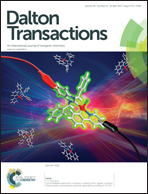Lipophilicity-dependent ruthenium N-heterocyclic carbene complexes as potential anticancer agents†
Abstract
Five Ru(II)–N-heterocyclic carbenes (NHC) (1–5) were synthesized by reacting the appropriately substituted imidazolium chlorides with Ag2O, forming the NHC-silver chloride in situ followed by transmetalation with dimeric p-cymene ruthenium(II) dichloride. All the complexes were characterized by NMR and ESI-MS, and complex 1 was also characterized by single-crystal X-ray diffraction. The IC50 values of these five complexes were determined by the MTT-based assay on four human cancer cell lines, SKOV-3 (ovarian), PC-3 (prostate), MDA-MB-231 (breast) and EC109 (esophagus). The cytotoxicities of these complexes changed from a moderate effect to a fine one, corresponding to the increasing lipophilicity order of the complex of 2 < 1 < 3 < 4 < 5 (0.91, 0.88, 1.36, 1.85 and 2.62 for 1–5 respectively). Complex 5 showed the most cytotoxicity with the IC50 values 10.3 ± 0.3 μM for SKOV-3, 2.9 ± 0.1 μM for PC-3, 8.2 ± 0.6 μM for MDA-MB-231, 6.4 ± 0.2 μM for EC109 cell lines. Due to the superior cytotoxicity of complex 5 against the PC-3 cell lines, further biological evaluations were carried out to elucidate its action mechanism. The morphologic changes and cell cycle analysis showed that complex 5 can inhibit PC-3 cell lines by inducing cell cycle arrest at the G2/M phase. The DNA binding experiments further demonstrate that complex 5 has a better binding ability for DNA (Kb = 2.2 × 106 M−1) than complexes 1–4 (3.8 × 105, 7.0 × 105, 5.7 × 105, and 1.9 × 105 respectively).


 Please wait while we load your content...
Please wait while we load your content...